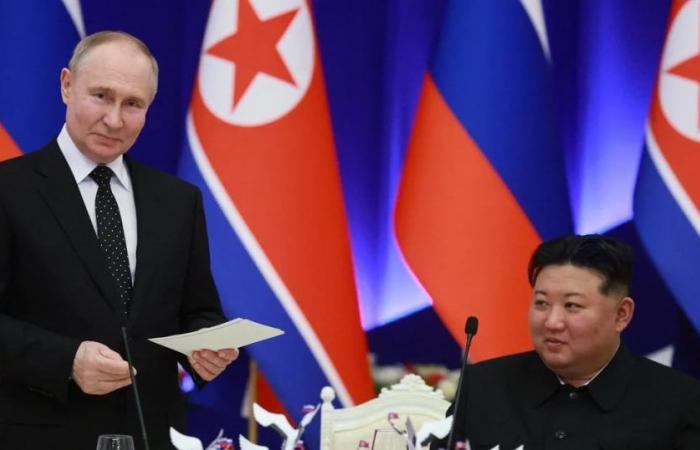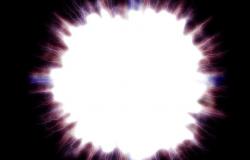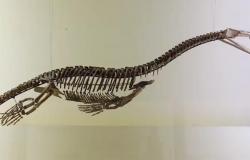
The Russian president Vladimir Putin and the North Korean leader Kim Jong-un They signed a mutual defense pact this week, pledging to “immediately provide military assistance” to the other in the event of an attack. The agreement formalizes a pact that has been strengthened since Putin’s invasion of Ukraine: Ammunition-hungry Moscow and cash-strapped Pyongyang, both under tough international sanctions, are more than happy to do business.
Two days before the meeting, the US State Department estimated that North Korea had supplied more than 11,000 containers of ammunition to Russia since September.
A new analysis of domestic Russian trade data clarifies how shipments of suspected North Korean munitions were distributed through Russia.
The data, obtained by the non-profit global security organization C4ADS and provided to Washington Postthey cover the shipments from August to January and show that more than 74,000 metric tons of explosives were distributed from two ports in the Russian Far East to 16 locations located mainly along the country’s western borders, near Ukraine. That weight is equivalent to about 1.6 million artillery shells of the type Russia has used in the war.
According to C4ADS, the locations where the merchandise arrived indicated that it was ammunition, even though the documentation referred to it as explosives.
The data does not include the origin of the shipments, but an analysis of ThePost and C4ADS found evidence of Russian ship movements between North Korea and Russia during the same period.
“This is the closest thing to proof of the connection between Russia and North Korea when it comes to ammunition transfers, and this shows that the Russians and North Koreans were lying” in denying the transfers, Go Myong-hyun said. , a senior researcher at the Seoul National Security Strategy Institute, affiliated with South Korea’s intelligence agency.
“It really gives more credence to the fact that North Korea is helping Russia carry out its war in Ukraine,” Go said. “Unless we have pictures, or the North Koreans say, ‘Look, we’ve been transferring shells to Russia,’ or something like that, this is the best we can get.”
Analysis of satellite images and maritime traffic data by ThePost and C4ADS shows that Russian-flagged ships linked to the country’s army docked in the North Korean port of Rajin and later in the Russian ports of Vostochny and Dunai. According to the data, most of the explosives left for locations in Russia within a week of their arrival.
These ships – the Lady R, the Angara, the Maria and the MAIA-1 – are owned by Russian companies closely linked to the country’s military. Although it is impossible to verify exactly what the ships were carrying, the United States and South Korea have previously publicly identified the four ships as being involved in transporting North Korean weapons to Russia based on satellite images and media reports.
The influx of North Korean ammunition helped tip the war in Russia’s favor, according to Michael Kofman, senior fellow at the Russia and Eurasia Program at the Carnegie Endowment for International Peace. It has been one of the “critical factors affecting the conduct of operations and who has the advantage in a war characterized by attrition,” Kofman said.
The Royal United Services Institute (RUSI), a think tank British, which also uses satellite images to monitor movements between North Korea and Russia, observed the same patterns. The group found 27 shipments between the North Korean port of Rajin and the two Russian ports between approximately the same period, estimating that thousands of containers had been moved, although their content remains unknown.
The shipments were headed to 16 locations across Russia, 12 of them near known ammunition storage facilities.according to commercial data, which C4ADS obtained from a person with access to documentation in the Russian transport and logistics industry, to whom ThePost does not identify for security reasons. This indicated to experts that these explosives were likely munitions.
Facilities near the locations listed in the data are related to artillery and rocket storage, and some may store artillery ammunition and other armored vehicles, said Dara Massicot, senior fellow at the Carnegie Foundation for Science’s Russia and Eurasia Program. Peace International, which reviewed the findings at the request of ThePost.
There was also facilities that depend on the department of the Russian Ministry of Defense which oversees weapons procurement for the Russian military, known as GRAU, and those facilities typically store artillery rounds, rockets, missiles and many other types of ammunition, Massicot said.
“Although we cannot be sure what exactly they are delivering, the labels on the explosives… and delivery to storage bases near Ukraine and to sensitive GRAU munitions storage facilities elsewhere in Russia suggest “These shipments are likely delivering a variety of munitions types to Russia, from artillery rounds to rockets,” Massicot said.
Satellite images show visible changes in several of these locations. From September to December, containers appeared near ammunition depots. New protective berms were also observed in these places, indicating the expansion of storage areas.
“The massive accumulation of berms, commonly used to isolate explosives, indicates that these are probably munitions,” said Margaux Garcia, Russia analyst at C4ADS. “Furthermore, the fact that these shipments are traveling west toward the Russia-Ukraine border suggests that Russia intends to use these munitions in the war effort.”
More than five shipments were also sent to the JSC Voskresenskiy Aggregate Zavod (VAZ) missile assembly factory, located about 65 kilometers from Moscow and sanctioned by the United States.
Russia, whose ammunition reserves are running low in its war with Ukraine, has been relying on its few remaining allies to resupply, while isolated North Korea is always looking for ways to make money.
Rejected by the West for his invasion of Ukraine, Putin seeks partners who share his anti-Western stance, including China, Iran and North Korea. This week, Kim praised the “firm alliance” with Moscow and openly backed Putin’s war against Ukraine, the strongest support for the Russian invasion by any foreign leader.
Likewise, Kim faces increasing economic sanctions and isolation due to his nuclear ambitions. He needs food, fuel, cash and weapons technology, all of which Russia can provide.
Although it is unclear what North Korea has received in return so far, there are indications that Russian technology was used in North Korea’s recent efforts to launch a spy satellite into space, Yoo Sang told reporters last year. -bum, a member of South Korea’s parliamentary intelligence committee, citing the country’s intelligence agency.
© 2024, The Washington Post





